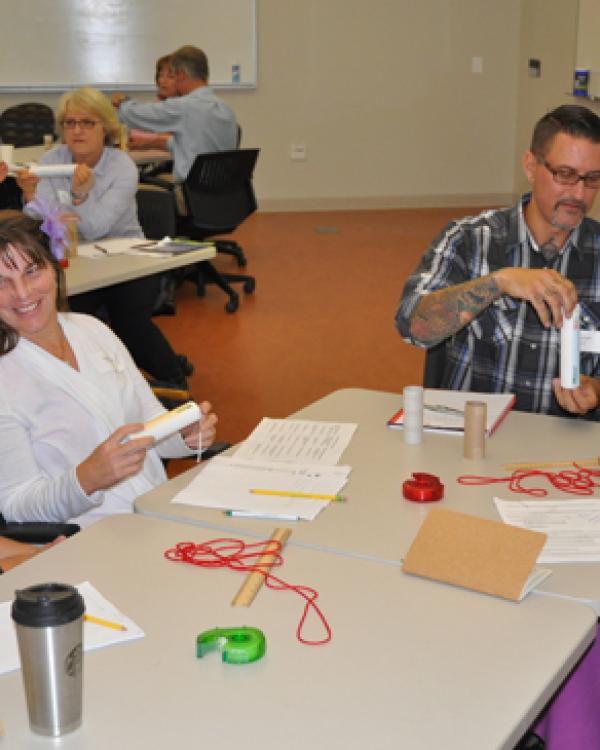
A room of Santa Barbara K-12 teachers and administrators are suddenly put in the position of their students, as Dr. Susan Johnson, her colleague Dr. Darby Feldwinn, and UCSB undergraduate Breanna Johnson have handed out Mystery Tubes for them to examine. These foot-long cylinders actually say “Mystery Tube” on the side, and the biggest mystery seems to be what’s going on inside, for there are strings coming out both ends, that, at first don’t necessarily seem to be connected, as the participants learn as they pull, let hang, examine. More importantly than discovering the secret of the tube, they’re discovering scientific practices, learning to think like scientists.
Johnson also guides them to think like teachers need to think under the new Common Core for English and Mathematics, and A Framework for K-12 Science Education and the Next Generation Science Standards, the later two ofwhich describe and promote eight scientific and engineering practices. She has the practices posted on a slide so the participants can see how those practices are integral to the process of examining the Mystery Tubes and developing conceptual models for what is inside. The Framework and Next Generation Science Standards parallel the Common Core standards for Mathematics and English and are purposefully developed to support each other. Language arts, for example, is now to be incorporated into science teaching, and this first workshop is building to a place where the teachers can see how to make that happen and work with UCSB faculty towards that end.
This breakout session is just one of the six that took place on June 21st when 76 teachers and administrators attended the day-long workshop “Common Threads in the Common Core: Teaching Tools, Assessments, and Subject Matter Integration,” sponsored by the Office of Education Partnerships and the Gevirtz School on the UC Santa Barbara campus. The event was led by Tim Dewar, Director of the South Coast Writing Project, Sue Johnson and Darby Feldwinn, co-directors with Petra van Koppen of the South Coast Science Project, and Chris Ograin, Director of the UCSB Mathematics Project. The day covered crucial topics such as: discussing what is new and significant in the smarter balanced assessments; providing teaching tools to prepare students for the new assessments; presenting how to support integrated literacy across content areas; and learning the practices in science and mathematics that integrate into language arts.
Reflecting upon the day at its conclusion, Tim Dewar attested to the power of teachers working together. “Here we are a room full of teachers, five hundred yards from the beach on a beautiful summer day, and we have chosen to stay in this room and do math problems, investigate black boxes, and take sample tests,” he told the group. “We’re not crazy. We are committed to improving educational outcomes for our students. And we know we can do this by working together.”
“It was an important event for teachers for many reasons,” explained participant Heidi Craine, a 4th grade teacher at Montecito Union School. “First, it was an engaging day of teachers teaching teachers about best practices for helping their students learn and make their understanding visible, and also it was a wonderful opportunity to explore how the CCSS will impact schools, teaching, and classrooms for years to come. It was successful in many ways. All sessions were heavily attended with participants eagerly participating in hands on activities. Additionally, when asked to reflect on the day, many of the participants asked for more days of learning and growing together exactly like this one.”